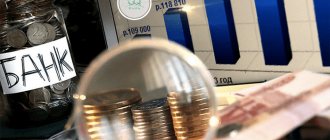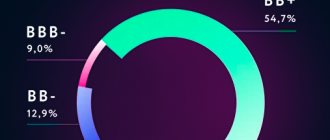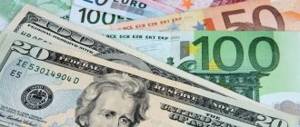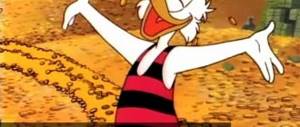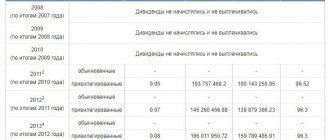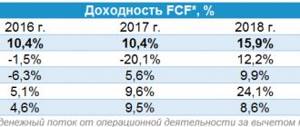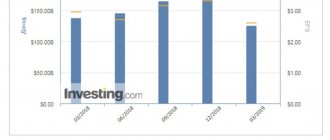Why buy currency?
As a rule, the main purpose of converting savings into foreign currency among ordinary citizens is the desire to protect their hard-earned funds from inflation. Unfortunately, over the past decades, the ruble has repeatedly shown extremely low stability and a tendency to instantly fall even after a small adverse impact, which has led to a significant decrease in public confidence in the government and the banking system of the state as a whole. As for investors, they buy foreign banknotes not only to insure capital, but also to make money on fluctuations in stock quotes. Why this idea looks attractive:
- Despite the government’s assurances, the ruble remains stable only over a period of two to three years. For example, over the past 15 years it has fallen in price almost four times;
- You don't need a lot of capital to buy currency. For example, owners of electronic wallets can exchange even 50–100 rubles for dollars or euros;
- To choose which currency is best to buy now, you don’t have to study the theories of fundamental analysis and complex exchange instruments;
- Buying currency is the simplest and most accessible investment tool for preserving capital and protecting your savings from inflation.
The disadvantages of storing savings in foreign currency are no less important than the advantages. If you don't take their influence into account, you can end up with some pretty unpleasant problems. So:
- When figuring out which currencies can be bought at a bank, one cannot help but note the modesty of the offer. Finding the same yen or francs in Russia will be extremely difficult;
- Storing currency is quite inconvenient. In the apartment, savings are threatened by fires and thieves, and in the bank account - by the state and bailiffs;
- Even experts are unable to reliably predict which currency to buy in order to save money. Fluctuations in exchange rates are difficult to analyze;
- Banks and exchanges always sell currencies at a higher price than they buy. If this difference is significant, you will have to wait a long time for the right moment to gain profit.
Forecast of the Swiss franc to Russian ruble exchange rate for today and tomorrow
Convert
CHF
Forecast for tomorrow
79.12 ₽
The current exchange rate of the franc to the ruble according to the Central Bank of the Russian Federation is 79.075 ₽ (seventy-nine rubles eight kopecks). The value of the Swiss franc increased by ₽(). The predicted average exchange rate of the franc for tomorrow will be 79.12 ₽ (seventy-nine rubles twelve kopecks).
- Forecast of the Swiss franc to Russian ruble exchange rate for today and tomorrow
- Franc to ruble exchange rate forecast chart
- Forecast of the franc to ruble exchange rate for the week and month
- Forecast of the Swiss franc to ruble exchange rate for the year
Recent Improvements
The ECB's quantitative easing program was expected to weaken the value of the euro, which might have required the SNB to print even more francs to maintain the cap. To prevent the EUR/CHF exchange rate from falling below 1.20, the SNB created francs and used them to buy euros.
The continued printing of francs has raised some concerns about hyperinflation among the Swiss population and increased pressure on the SNB to take action to remove the peg.
According to the daily EUR/CHF chart, the franc recovered about 50% before meeting major resistance at this level. after a sharp drop on January 15, 2015.
Coins[edit | edit code]
Circulating coins[edit | edit code]
Coins are regularly issued in denominations of 5, 10 and 20 rappen (centimes), 1/2, 1, 2 and 5 francs. The minting of 1 rappen coins was discontinued in 2006, and the 2 rappen coins were discontinued in 1974.
Coin Metal Changes:
- 1939 - 20 rappen made of copper-nickel alloy (1850-1859 - billon, 1881-1938 - nickel);
- 1968 - 1/2, 1, 2 and 5 francs in copper-nickel alloy (formerly silver);
- 1981 - 5 rappen made of copper-aluminum-nickel alloy (formerly copper-nickel alloy).
| Image | Denomination | Diameter (mm) | Thickness (mm) | Weight (g) | edge | Material |
| 5 rappen | 17,15 | 1,25 | 1,8 | smooth | Cu+Al+Ni 92/6/2 | |
| 10 rappen | 19,15 | 1,45 | 3 | smooth | Cu+Ni 75/25 | |
| 20 rappen | 21,05 | 1,65 | 4 | smooth | ||
| 1/2 franc | 18,2 | 1,25 | 2,2 | ribbed | ||
| 1 franc | 23,20 | 1,46 | 4,4 | ribbed | ||
| 2 francs | 27,4 | 2,06 | 8,8 | ribbed | ||
| 5 francs | 31,3 | 2,33 | 13,2 | smooth with and 13 stars |
Commemorative coins[edit | edit code]
From time to time, commemorative and thematic commemorative coins are issued, usually in denominations of 10, 20 and 50 francs, for example:
Is it worth buying rubles?
When speaking about what currency can be bought in Russia, ordinary citizens and even financial experts most often mean dollars, euros or some rarer monetary units. Meanwhile, the familiar ruble is also an instrument for storing capital. The difficult spring of 2021 caused many investors to doubt its effectiveness, but since then the situation has generally stabilized. Today, some experts even put forward theories about the likely return of the ruble to its previous exchange rate. Whether this is so can be understood after analyzing the factors influencing quotes:
- In connection with the US presidential elections in the fall of 2021, new anti-Russian sanctions are expected to be introduced in the near future to popularize the candidate;
- Russia's budget for 2021 was planned in accordance with inflation of 3–4%, but in reality it was only 2%. Therefore, the Central Bank of the Russian Federation may weaken the ruble;
- The settlement of the oil conflict contributed to the stabilization of the ruble. Growth will begin as hydrocarbon reserves created by buyers in the spring are depleted;
- Due to the low discount rate, capital inflows should not be expected in the near future. Investors simply won't be able to choose which stocks to invest in;
- To stabilize the national currency, the Central Bank is taking all necessary measures. So, in the spring he has already sold more than 74 billion rubles from the reserve fund;
- The exit from quarantine is happening unevenly in different regions. This slows down export-import operations and impedes industrial recovery.
Technical analysis
In the previous article, I already talked about the importance of correct analysis of the DXY dollar index as the main factor in the change in the exchange rate of currency pairs traded against the US dollar (see article here).
The Swiss franc was no exception to the rule. The chart above shows that its correlation with the index is approaching 1. Therefore, for correct analysis of the USDCHF pair, it is first of all important to understand what is happening with the US dollar itself.
In last week's article, I noted global trends in the index. Then I noticed the global bearish trend within the descending triangle.
However, locally, DXY is at historical lows and near strong support levels. I expected consolidation within a local triangle and a short bullish correction.
But the market decided otherwise and updated the historical minimum.
The monthly chart of the DXY index shows that it has broken through an important local bullish trend. The next serious support level will only be found at the February 2021 low around 88.25 points. At the same time, the index broke through the annual S3 level from Pivot Fibonacci, which indicates, on the one hand, that the dollar is oversold, and on the other, a strong bearish impulse.
There is no significant support visible on the four-hour chart above. The monthly S3 level from Pivot Fibonacci is located in the area of 90.73 points. The index begins the new month at the equilibrium level, and therefore, movement to the border with S3 is an adequate scenario. There, close by, is the lower boundary of the channel, which is a magnet for the index from the point of view of technical analysis. At the same time, none of the oscillators give reversal signals. While everything is looking down.
Now we move smoothly to the analysis of the USDCHF pair itself. Like the DXY index, the pair broke through a strong support level in the form of an increasing trend line. The pair also broke through the low of February 2021 and the next serious level of the pair can only be found in the area of the historical low of August 1, 2011 in the area of 0.70 CHF.
The chart above shows the DXY index and USDCHF together for comparison. It can be seen that starting from 2021, the dynamics of these two instruments are almost the same. So far there are no strong support levels for the Swiss franc and there are no signs of a trend reversal.
The daily chart above, as well as the DXY index, shows a bearish picture. USDCHF is below the equilibrium level of the monthly Fibonacci Pivot. The MACD indicator completes the correction and turns down. There are no serious divergences. The ROC TD indicator is in the equilibrium zone and is inclined to go down.
All this points to the possibility of further decline.
Is it worth buying euros?
Of course, the European Union, as an association of almost three dozen states with different economic and cultural characteristics, has many internal problems. At the same time, no experienced investor will take a long time to figure out which currency is best to buy now in 2021: according to experts, it is reasonable to keep at least a quarter of your savings in euros. This monetary unit is a payment instrument for 350 million people, and its exchange rate does not depend on the state of affairs in any one state. What you need to pay attention to today:
- In connection with A. Merkel’s refusal to participate in the political race, the elections in Germany, postponed to the fall, may lead to a revision of the policy of the European Union as a whole;
- The refugee problem caused by the conflict in the Middle East has not been resolved by EU states. Meanwhile, huge amounts of money are allocated for benefits to emigrants;
- Zero rates on deposits and debt securities initiate capital outflow. Investors simply have no options on where to invest their money to make it work;
- The prospects for launching a gas pipeline from Russia remain vague. The US is trying to force the EU to block the project and switch to purchasing American gas;
- The British Parliament has finally decided on the format for leaving the European Union. Under this decision, the Kingdom will maintain close trade ties with the rest of Europe;
- Due to a serious decline in production in 2021, EU GDP increased by only 0.3%. Now everything depends on the strategy to overcome the consequences of the epidemic.
USDCHF trading plan until the end of 2021
USDCHF is in a strong bearish trend. The nearest target is around 0.880 CHF. If the dollar devaluation does not accelerate, the consolidation around this level may last until the end of the year.
Trading plan until the end of the year:
- Short from current levels. The ideal selling level at the upper border of the channel is 0.907 CHF.
- The short target lies at the support level of 0.880 CHF.
- A stop is needed in case of exit from a bearish trend - lower as the goal is reached. The starting position is around 0.917 CHF.
The Swiss franc as a world currency[edit | edit code]
The Swiss franc is used as a reserve currency due to its stability, although the share of total foreign exchange reserves in Swiss francs is generally below 0.3%.
International savings in foreign exchange reserves
| Currencies | 1995 | 1996 | 1997 | 1998 | 1999 | 2000 | 2001 | 2002 | 2003 | 2004 | 2005 | 2006 | 2007 | 2008 | 2009 | 2010 | 2011 | 2012 | 2013 | 2014 |
| USD | 59,0 % | 62,1 % | 65,2 % | 69,3 % | 70,9 % | 70,5 % | 70,7 % | 66,5 % | 65,8 % | 65,9 % | 66,4 % | 65,7 % | 64,1 % | 64,1 % | 62,1 % | 61,8 % | 62,3 % | 61,1 % | 61,0 % | 63,1 % |
| EUR | 17,9 % | 18,8 % | 19,8 % | 24,2 % | 25,3 % | 24,9 % | 24,3 % | 25,2 % | 26,3 % | 26,4 % | 27,6 % | 26,0 % | 24,7 % | 24,3 % | 24,4 % | 22,1 % | ||||
| DEM | 15,8 % | 14,7 % | 14,5 % | 13,8 % | ||||||||||||||||
| GBP | 2,1 % | 2,7 % | 2,6 % | 2,7 % | 2,9 % | 2,8 % | 2,7 % | 2,9 % | 2,6 % | 3,3 % | 3,6 % | 4,2 % | 4,7 % | 4,0 % | 4,3 % | 3,9 % | 3,8 % | 4,0 % | 4,0 % | 3,8 % |
| JPY | 6,8 % | 6,7 % | 5,8 % | 6,2 % | 6,4 % | 6,3 % | 5,2 % | 4,5 % | 4,1 % | 3,9 % | 3,7 % | 3,2 % | 2,9 % | 3,1 % | 2,9 % | 3,7 % | 3,6 % | 4,1 % | 3,8 % | 3,9 % |
| FRF | 2,4 % | 1,8 % | 1,4 % | 1,6 % | ||||||||||||||||
| CHF | 0,3 % | 0,2 % | 0,4 % | 0,3 % | 0,2 % | 0,3 % | 0,3 % | 0,4 % | 0,2 % | 0,2 % | 0,1 % | 0,2 % | 0,2 % | 0,1 % | 0,1 % | 0,1 % | 0,1 % | 0,3 % | 0,3 % | 0,3 % |
| Others | 13,6 % | 11,7 % | 10,2 % | 6,1 % | 1,6 % | 1,4 % | 1,2 % | 1,4 % | 1,9 % | 1,8 % | 1,9 % | 1,5 % | 1,8 % | 2,2 % | 3,1 % | 4,4 % | 5,1 % | 6,3 % | 6,5 % | 6,9 % |
Sources:
|
The Swiss franc is an international means of payment for the payment of fees and charges for the international registration of trademarks in accordance with Rule 35 of the “Common Regulations relating to the Madrid Agreement Concerning the International Registration of Marks and the Protocol thereto”[12].
USDCHF trading plan for September 2021
If you hurry, then this week there is an opportunity to sell shorts:
- Entry on current positions, around 0.900 CHF.
- The target is the lower border of the channel and S3 - 0.8868 CHF.
- It is better to place the stop outside the equilibrium level of the monthly Pivot - 0.910 CHF.
The Profit/Risk ratio is not the best, only 1.61, so entry is only permissible with a small lot.
The next promising trade is expected to occur on a rebound from the lower border of the bearish channel. The opening date is approximately in the middle of the month.
- The level for opening a long position next to the support line S3 is 0.886 CHF.
- The stop is moved beyond the boundaries of the bearish channel and the support level of 0.880 CHF.
- The target for the trade is 0.908 CHF.
The Profit/Risk ratio for this position is much better and is around 3.13. Please follow your personal risk management rules when trading.
If you have just started mastering trading, then it is better to take your first steps on a demo account.
Good luck and good profits!
Sincerely,
Mikhail @Hypov
PS Did you like my article? Share it on social networks, this is the best thank you 
Ask me questions and comment below. I will be happy to answer and give the necessary explanations.
Useful links:
- I recommend trying trading with a trusted broker here. The system allows you to trade independently or copy transactions of successful traders from all over the world.
- Use my promotional code BLOG to receive a 50% deposit bonus from LiteForex. You just need to enter the promotional code in the appropriate field when replenishing your account in the LiteForex platform and the bonus will be credited simultaneously with the deposit.
- Traders chat in telegram: https://t.me/marketanalysischat. We share signals and experiences.
- Telegram channel with excellent analytics, Forex reviews, educational articles and other useful things for traders: https://t.me/forexandcryptoanalysis
Is it worth buying yuan?
The Chinese economy, with a GDP of $14 trillion, ranks second in the world rankings, lagging behind the American one by only 30%. Therefore, the rises or falls in the yuan exchange rate, which were observed in 2021, are unlikely to seriously undermine its stability. Of course, with the beginning of the trade confrontation with the United States, many investors began to doubt which currency to buy now, but the effective fight against the crisis and the consequences of the viral pandemic showed the high potential of the Chinese currency. Other things to consider:
- The increase in trade transactions between China and other countries, as well as the government’s desire to make payments in national currency, increases the demand for the yuan;
- Today, there has been serious progress in resolving the trade conflict between China and the United States, although final agreements have not yet been reached;
- Some weakening of the currency was caused by news of repeated outbreaks of coronavirus diseases, but the government managed to stabilize the situation;
- Despite the problems, the Chinese government has not created significant pressure on the yuan and has avoided an active outflow of investor capital;
- In contrast to the United States, China has created its own cryptocurrency, CBDC, which in the future may become a massive means of mutual settlements throughout East Asia;
- Thanks to the launch of affordable credit programs and policy easing by the Bank of China, the yuan avoided the fate of other currencies in the region and fell by only 0.4%.
About Admiral Markets
We are a broker with a global presence and are regulated by various financial regulators. We provide access to over 8,000 financial instruments such as Forex and CFDs on shares, indices, bonds, commodities, ETFs and cryptocurrencies, as well as investment opportunities in real shares and ETFs.
With Admiral Markets you can use the most innovative trading platforms such as MetaTrader 4 and MetaTrader 5, as well as the exclusive MetaTrader Supreme Edition plugin, for free.
Download the world's #1 multi-asset trading platform, MetaTrader 5, completely free by clicking on the following banner.
Should you buy Swiss francs?
Switzerland has remained a state that avoids economic and political conflicts for many decades. Therefore, not only Swiss banks, but also the national currency are considered the most reliable instruments for saving and protecting funds. Despite close trade relations with the European Union, the country avoided a downturn in its economy during the crisis, and the Swiss government's actions indicate complete control over the franc's position on world markets. An additional advantage for investors will be the fairly wide availability of this currency. Things to consider:
- The Bank of Switzerland left the discount rate unchanged at -0.75%. This forces investors to invest money not in deposits, but in real enterprises;
- The decline in the country's GDP growth rate, which began in 2021, has now almost stopped. Experts predict active industrial development;
- The country's external trade balance has remained positive for decades. In the spring, the excess of exports over imports amounted to 2.8 billion francs;
- Switzerland's main trading partner is Germany, to which the state sells a huge amount of complex high-tech goods;
- At the beginning of the summer, franc inflation increased from -0.7% to 0%, which showed the wisdom of the financial policy of the Bank of Switzerland;
- To stimulate the economy, the government weakened the currency by 1.2%, but during the last crises the franc showed high stability.
Show more
Show more
Sophie Taeuber-Arp: decorating Swiss money
This content was published on Oct 30, 2014 Oct 30, 2014 Swiss artist Sophie Taeuber-Arp has been almost completely forgotten, even though her face graces the 50-franc note. It's time to remember her.
